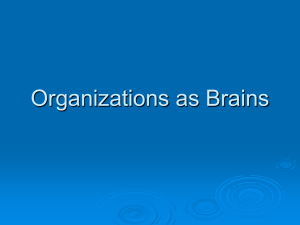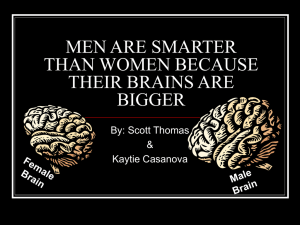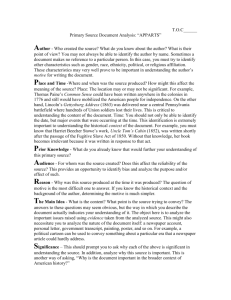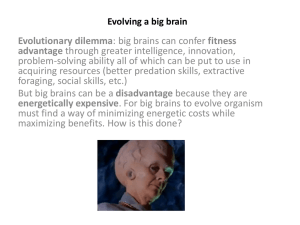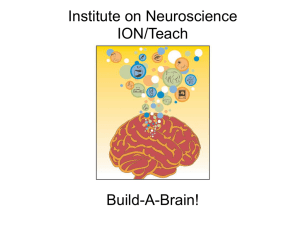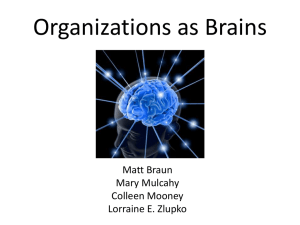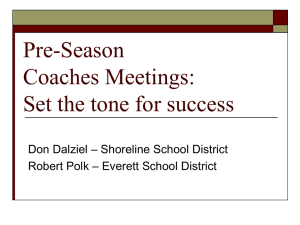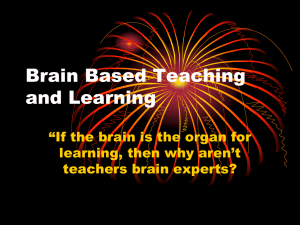Learning in a Brain Compatible Classroom
advertisement
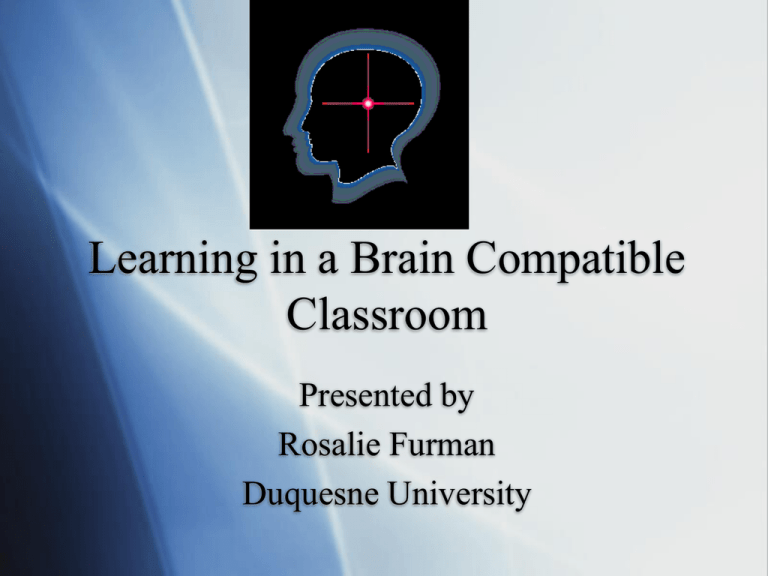
Learning in a Brain Compatible Classroom Presented by Rosalie Furman Duquesne University BRAINO Please choose 9 words from the following list and complete your Braino card: Amygdala Cerebral Cortex Dendrites Axon Cortisol Endorphins Dopamine Corpus Callosum Paraphrase Passport Simultaneous Roundtable Affirmation Mozart Effect Mindmap Semantic Memory Episodic Memory Hippocampus How would you title this picture? Inside-Outside Circle Share your title with other students. Affirmations Point to someone and say, “You are a genius!” Affirmations make firm that which you value. Affirmations model a habit of affirming others instead of criticizing. Confucius say: 五十而知天命) “It is easier to ride a horse in the direction that he is already headed.” What is brain compatible learning? Brain compatible learning is understanding what the brain needs for optimal learning potential and then creating a teaching environment to accommodate those needs. The Five Principles of Brain Compatible Learning 5 3 4 2 1 Five Principles of Brain Compatible Learning How would you accommodate these principles in your school and classroom? 1. Brains seek safety and security 2. Brains need nourishment 3. Brains need social interaction 4. Brains are emotional 5. Brains seek and process information I. Brains Seek Safety and Security • The brain’s primary goal is always survival. When we are frightened, threatened or anxious, our primitive fight-or-flightdefense alarm systems kick in and we downshift into “primitive survival mode”. Stress and Anxiety Threat or anxiety decreases the probability of learning. Boredom Lack of challenge results in little or no learning. Low threat + High Challenge & Motivation =Relaxed Alertness Higher-level thinking occurs when we are in a state of relaxed-alertness Cerebrum Corpus Callosum Thalmus Hippocampus Cerebellum Amygdala Brain Stem Practice Providing Safety • • Smile Use humor Establish routines and procedures Engage in classbuilding activities Create smaller communities of learning Teach to instructional levels for success Provide a supportive, non-threatening classroom climate II. Brains Need Nourishment • We need to feed our brain! • The brain weighs only 3 pounds, which is about 2% of our bodies weight, BUT consumes 20% of our body’s water and energy. • It takes a lot of energy to feed 100 billion neurons. A Neuron Dendrites Axon Cell Body The brain is fed by: Food Water Oxygen The Environment Sleep Music Why Music? Music creates mood states: Music can “charge and energize the brain” Music can carry instruction. Music can signal and prepare the brain. Music can boost intelligence. Provide Nourishment in the Classroom Provide healthy snacks. Include green leaf and flowering plants in your classroom to cleanse the air. Monitor sleep habits of your students. Provide students with water bottles so they remain hydrated. Include exercise daily. Provide music in the school. Music, Mix, Freeze Share with a colleague something that you have learned that has some personal meaning to you. III. Brains need Social Interaction Brains are far more active when interacting with others: Discuss Debate Learn cooperatively Cooperative Structures Think Pair Share Paraphrase Passport Numbered Heads Say Something Expert Jigsaw Literature Circles Question Generator Talking Chips/Drop a Chip Think-Pair-Share Teacher poses question Teacher allows for “Think Time” Students pair and discuss responses Paraphrase Passport One student shares response. The other student restates the information. “In other words…” “Are you saying…?” Say Something Teacher poses question for partners to discuss “Say something that disagrees with that point of view.” “Say something to share how that information makes you feel.” What makes an outstanding teacher? 1. Think about your response. 2. Taller partner shares his/her response. 3. Shorter partner paraphrases. 4. Repeat Numbered Heads Each student in the team has a number. After team discussion, teacher chooses one number to share-out for the whole group. This ensures active listening and individual accountability Expert Jigsaw Students become teachers Literature Circles Reader: Chooses a special part to read aloud Question Generator: Creates questions Responder: Answers question Clarifier: Paraphrases responses Augmenter: Adds additional information to answer Connector: Connects information to self Praiser: Exaggerates affirmation Talking Chips Student get “x” amount of chips, and must make that number of contributions to the team. Drop-a-Chip Students give a chip that has a specific meaning to other members of the team. “I really like that idea.” (Drop a Praise chip) Take Brain Breaks The brain needs physical as well as mental breaks: Energizers Silly Sports Stretching Snacks Recess Dance Creative Expression Circle 11 1. Form a circle of four to six 2. Say: One, Two, Three: ELEVEN making a fist in the middle of the circle 3. On the count of eleven, players open their fist to reveal from zero to five fingers. 4. Add the sum of the group’s fingers. 5. Your group did it? Change the number. IV. Brains are Emotional Close your eyes and remember an incident from your childhood. Our brains are better able to recall that which is associated with emotion--that which makes us “feel”-is remembered. Emotions are Critical to Learning Emotionally-laden experiences generate more interest, engagement, and retention because emotional learning has preferential processing in the brain. Emotional Events Get Preferential Encoding Engage emotions… • Through the use of stories, videos, pictures and activities. • By asking students how they “feel” about topics. • By debating emotionally-charged topics. • Through the use of drama, theater, and expressive arts. Museum Walk In a small group (using your bodies) create a sculpture representing something you have learned today. Be prepared to share the title of your sculpture. V. Brains Seek & Process Information Engage multiple memory systems to enhance the brain’s ability to retain. Semantic: Fact memory Procedural: Skill memory Episodic: Episode memory Working: Thinking memory Spatial: Map Memory Semantic Memory Content knowledge, facts, formulas, etc. Semantic memory is created through repeated practice. “Practice makes Perfect” Build bridges to connect new learning Use mnemonic devices Test later Use Novelty Bio Poem First name: Four descriptive traits: Sibling of or son/daughter of: Lover of: Who fears: Who needs: Who gives: Who said: Resident of: Last name: Procedural Memory Sometimes called “motor memory” or “muscle memory”. We acquire procedural memory by doing-writing, drawing, etc. Skills require repeated practice but eventually become automatic. Test procedural memory through authentic assessments. Episodic Memory Episodic memory is designed for one-time events--easily forgotten. Write it to memory: journals, diaries, etc. Relive the event by drawing or discussing. Vary your delivery in the classroom--make it memorable—no front of room. Ask students to change seats—even it’s just for a few minutes. Working Memory This is the short-term memory system where we hold the things that are at the forefront of our minds (literally). The more information in working memory, the less capable students are of new learning. Process learning to move to long-term memorywrite, draw, discuss, mind mapping, etc. Reflect on learning (metacognition) Mind Mapping Is a process of visually depicting a concept with symbols, images, colors, key words, and branches. Spatial Memory Spatial memory is our natural memory system strongly rooted in evolution. Includes our mental maps of where physical objects are located in our environment. Retain information by visually and physically organizing it--graphic organizers, mind maps, visual cues. Brains Seek Novelty The brain can process the teacher’s voice while making judgments about the tone quality, the teacher’s dress, hair style, as well as the student sitting next to him/her, the temperature of the room, distracting noises, etc. etc. etc. • “Are you paying attention?” • Prime with content--Surprise with process • Avoid habituation Brains Need Immediate Feedback Focus feedback on ways to improve rather than overall evaluations. Traditional workbook work is feedback-poor. Build feedback into each lesson- Checking for understanding techniques: Signals Individual chalkboards Questioning Strategies Exit Tickets, etc. Brains Seek Patterns to Construct Meaning X A B C Order Linking Connections Facts Learned in Isolation are Soon Forgotten Thematic teaching Integrated language arts Interdisciplinary instruction Graphic Organizers (make the invisible visible) Using organizers allow learners to replicate patterns or excellence. Brains Seek Meaningful Learning Relate and Motivate: Link content to student interests Cultivate Meaning: Have students explain in their own words, negotiate meaning, write about how the knew knowledge fits into their mental schema. Focus on Process -- Not Outcome. Students learn more from the process of searching for meaning than from retrieving an answer. Closure ABC’s of Brain Compatible Learning No Other Profession No other profession changes more lives. No other profession instills more pride. Through children’s eyes you’re a guiding light, A beacon down life’s road. Your work is like no other profession in the world.

